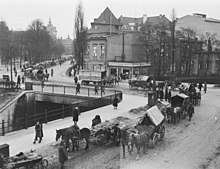Siege of Danzig (1945)
| Siege of Danzig | |||||||
|---|---|---|---|---|---|---|---|
| Part of East Pomeranian offensive | |||||||
 Flight of Germans from East Prussia a few weeks before the siege | |||||||
| |||||||
| Belligerents | |||||||
|
|
| ||||||
| Commanders and leaders | |||||||
|
|
| ||||||
| Units involved | |||||||
| 2nd Army (Wehrmacht) | 1st Kosciuszko Division | ||||||
| Casualties and losses | |||||||
| Unknown | Unknown | ||||||
The siege of Danzig was launched by the Red Army against Nazi Germany in March 1945.
Background
[edit]On 14 January, the 2nd Belorussian Front started an attack against the 2nd Army from their garrison in Pułtusk, and in the next ten days, they advanced quickly up the Vistula River. Danzig was eventually reached in early March, and as it was an important strategic location and the last German stronghold in the region, the Soviets started coordinating attacks.[1]
The battle
[edit]General Karl-Wilhelm Specht organised the defences. He was replaced by Dietrich von Saucken due to not agreeing to Hitler's policies on the defense of the city.[2] The Soviets began massive bombardments of Danzig on 15 March. A paratrooper unit was deployed in the Oliwa Forests (Lasy Oliwskie) on 18 March, which provoked the Soviets to enter it and start bloody fighting in the forest. The fight continued until 25 March and resulted in a Soviet victory. It is regarded as the most intense and bloody battle of the siege.[1]
On 21 March, the way to Nenkau was opened. On 22 March, the Soviets entered the city from the north (through Zoppot). On 24 March, Praust was taken, though it was not an important strategic move, as the areas nearby were flooded and the main offensives were in the north and west. After the takeover of Glettkau on 25 March, Soviet tanks continued their advance towards Brösen, though it was stopped by the 62nd Grenadier Regiment, which had recently entrenched in the region. Intense fighting broke out in the downtown in the next few days, though the combat within the city was more limited.[3]
In the following days, Oliwa would become another centre for artillery as the Soviets advanced through the city. On 27 March the Soviets captured Hagelsberg, a mountain in the region, and Neufahrwasser, an important port. Now, the gasworks in the Gdańsk Shipyard were only 100 metres away from Soviet-occupied territory. Fighting began in the remnants of German-held territory, and Śródmieście was burning. The lack of water and low accessibility caused the fire to continue, which did not give an advantage to either side.[2] Mass bombardments and common[clarification needed] Soviet attacks resulted in Red Army divisions in[clarification needed] the centre of the city to the mouth of the Vistula and its surroundings.[3] The Germans finally surrendered on 30 March.[4][1]
Aftermath
[edit]Danzig was left as ruins.[5] The bombardments, constant combat and continuous fires resulted in most of the city's landmarks being destroyed. On 30 March, the newly renamed Gdańsk was subject to the provisional government, which created the Gdańsk Voivodeship.[5] Mass deportation of Germans from the city started shortly after the battle in order to rise the government's popularity and manifest the new administration system.[6] By 1946, around 68% of the German population was gone.[2]
References
[edit]- ^ Jump up to: a b c Voellner, Heinz (31 August 2020). "Bitwa o Gdańsk 1945". wiekdwudziesty.pl. Retrieved 9 August 2021.
- ^ Jump up to: a b c Abramowicz, Mieczysław (27 February 2017). "GDAŃSKIE HISTORIE: Marzec 1945 - straszny koniec miasta Danzig". gdansk.pl. Retrieved 9 August 2021.
- ^ Jump up to: a b Gliniecki, Tomasz; Panto, Dmitriy (27 February 2017). "Krzywy obraz wojny. Armia Czerwona w Gdańsku i Prusach w 1945 r." (PDF). gdansk.pl. Retrieved 9 August 2021.
- ^ Stąporek, Marcin (15 March 2015). "Tak walczono o Gdańsk w 1945 roku". historia.trojmiasto.pl. Retrieved 9 August 2021.
- ^ Jump up to: a b Bogusz, Tomasz (4 April 2020). "Jak Sowieci "wyzwalali" Gdańsk w marcu 1945 roku?". twojahistoria.pl. Retrieved 9 August 2021.
- ^ Baliszewski, Dariusz (1999). Ilustrowany przewodnik po Polsce stalinowskiej 1944-1956.